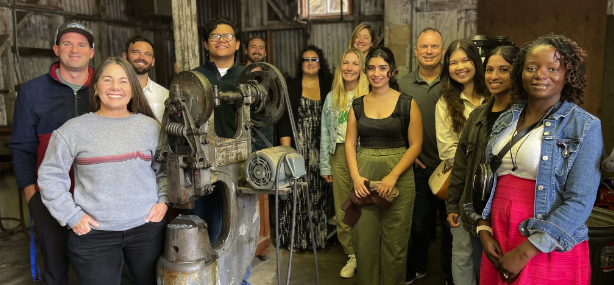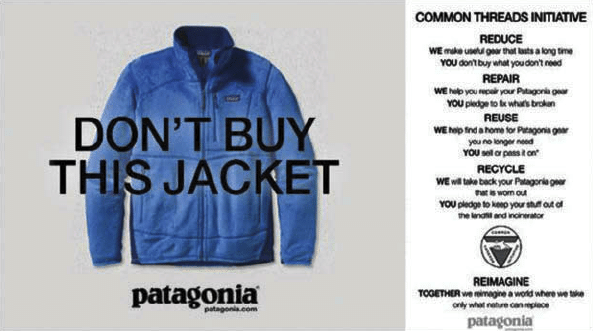- It All Began With a Man on a Mission
- What Makes Patagonia So Successful?
- Patagonia’s Impact on the Apparel Industry
- What's Next?
- Develop a Branding Strategy at MarcomCentral
Get news, updates, and insights delivered straight to your inbox.
Yvon Chouinard: How A Reluctant Businessman Built the Patagonia Brand

Yvon Chouinard is the founder of Patagonia, a brand that began in 1973 as a small climbing gear company and evolved into a leader in sustainable outdoor apparel. Chouinard, a rock climber passionate about the environment, built Patagonia with a focus on creating durable, functional products while championing environmental activism. Over the years, Patagonia’s marketing campaigns, such as the “Don’t Buy This Jacket” initiative, have solidified its position as a brand that prioritizes sustainability over consumption. With a commitment to using recycled materials and pledging 1% of sales to environmental causes, Patagonia has made environmental responsibility a core part of its identity.
Patagonia’s innovative marketing strategies, including the “Worn Wear” campaign that encourages product repair and reuse, reflect the company’s ethos of reducing waste and promoting longevity. The brand’s message extends beyond selling products to creating a movement for eco-conscious consumers, further enhancing its reputation as a leader in both outdoor apparel and environmental activism. Through these efforts, Patagonia continues to inspire change and demonstrate that business success and environmental responsibility can coexist.
From founding a rock-climbing equipment business and turning it into an empire of sustainably made outdoor clothing, this is the story of how rock climber and activist Yvon Chouinard created the Patagonia brand. Founded in 1973 in Ventura, California, Patagonia began selling climbing gear and later expanded to selling outdoor apparel and accessories.
Even with Patagonia’s expansion, founder Yvon Chouinard remained focused on making products sustainably, treating employees well, and engaging in corporate responsibility. Learn more about Patagonia’s history and how its consistent brand message has made it one of the most well-known sustainable companies.
It All Began With a Man on a Mission
Photo: Jim Richardson
Yvon Chouinard has been a successful businessman for nearly 50 years, although he would prefer to be called a craftsman. He is an avid lover of the outdoors, beginning rock climbing when he was only 14. He soon became a blacksmith and began making steel pitons for rock climbing, selling them to fellow climbers from his parents’ backyard.
After a few years, Chouinard started his first real business venture, called Chouinard Equipment, with his friend Tom Frost. Their goal was to improve rock climbing equipment and make it lighter, stronger, and easier to use.
They first sold Chouinard’s steel pitons, which were sturdy, dependable, and well-liked by climbers. However, they also damaged the rocks. Chouinard didn’t want to harm the environment he loved, so he decided to redesign the climbing tools. The new design was aluminum chocks that were introduced in the first Chouinard Equipment catalog in 1972. They were accompanied by an essay by Sierra climber Doug Robinson on how the chocks work. The chocks proved successful and helped the company gain more customers.
Soon, Chouinard Equipment began making apparel for outdoor pursuits, inspired by a rugby shirt that Chouinard got in Scotland that prevented chafing during climbs. The company eventually began to sell other shirts, raincoats, and accessories for climbers with quick-drying and insulated technologies. The first store, Great Pacific Iron Works, opened in 1973 in Ventura, CA. The location now serves as Patagonia’s headquarters.
By 1975, Chouinard and Frost disagreed on the future of the company, which eventually led to the breakdown of their partnership. Chouinard became the sole owner of the company, ultimately renaming it Patagonia. He chose this name after a transformative trip to the region of the same name in South America.
Over time, Patagonia expanded its product lines even further to offer outerwear, long underwear, backpacks, camping accessories, food items, and more outdoor essentials.
Along with its product expansion, Patagonia also expanded its sustainability and environmental protection efforts. In 1985, Patagonia pledged 10% of company profits to environmental conservation groups. It later increased its pledge and committed 1% of sales to conservation organizations.
Ever since, Patagonia has continued to focus on sustainability and activism efforts. The clothing brand became a B (benefit) Corporation in 2012, a certification given to companies that meet the highest standards of social and environmental performance.
In late 2022, Chouinard announced he was transferring ownership of the company into 2 new entities: the Patagonia Purpose Trust and Holdfast Collective. This move helps ensure Chouinard’s vision will be maintained, and that Patagonia’s profits will continue to be used to fight climate change.
What Makes Patagonia So Successful?
Currently, Patagonia operates more than 70 stores globally and two distribution centers. The outdoor brand has an estimated value of $3 billion and brings in $100 million in revenue per year, even though Patagonia founder Yvon Chouinard has said that profitability was never his goal. His mission was to make dependable climbing gear that didn’t harm the earth. He has been most successful in doing so with Patagonia for a few main reasons.
A Founder Who Resonates With His Target Audience
Chouinard’s philosophy is a large part of the success Patagonia has experienced. He has been described as a reluctant businessman and billionaire, even as his company has flourished over the years. He believes in doing business on his own terms: moving away from a growth-oriented mindset and moving toward one aimed at permanence and corporate responsibility. Patagonia has adopted this mindset by:
- Refusing to sell products that aren’t environmentally friendly
- Encouraging customers to reuse and recycle products and reduce their consumption
- Enacting other sustainability policies (using 100% organic cotton shirts, renewable energy, recycled fabrics)
- Reducing carbon emissions with environmental responsibility programs
The target market of Patagonia is active people who are environmentally conscious and are willing to spend more on sustainable products. Many of Patagonia’s customers are within this target market and they shop there because they resonate with Chouinard’s business philosophies.
However, by making sure every product sold is manufactured in an environmentally friendly way, Patagonia ensures customers support sustainability regardless of how much that factors into their purchasing decision.
Being at the Forefront of Sustainability
One of the main reasons for Patagonia’s success is its continued dedication to being a sustainable company. Patagonia was founded on Chouinard’s vision of a corporate business that didn’t cause harm to the environment. Since its establishment in 1973, Patagonia has been true to its mission and has proved it in many ways:
- In the early 70s, Patagonia made its first donation to save the Ventura River and its fish habitat from a development plan
- In 1985, Patagonia pledged 10% of company profits to environmental conservation groups
- In 1988, Patagonia began its first major campaign to protect the Yosemite Valley
- In 2001, Patagonia debuted the 1% for the Planet effort, where 1% of all sales are given to environmental groups
In the last decade, Patagonia has continued its sustainability efforts with various initiatives. The ‘Worn Wear’ program was introduced in 2017, which allows customers to return certain Patagonia items in exchange for new merchandise credit. These returned items would be cleaned, repaired, and resold on Patagonia’s “Worn Wear” website.
Patagonia also launched the Worn Wear Wagon, a mobile shop that traveled around the U.S. to repair customers’ Patagonia products free of charge and educate them on how to do the same.
Patagonia buildings also use renewable energy sources. Patagonia products are made from recycled and organic materials, and Patagonia Black Friday proceeds are donated to nonprofit environmental organizations.
Despite these tremendous efforts, founder Yvon Chouinard doesn’t see Patagonia as a sustainable company. He said in an interview with McKinsey, “We can’t delude ourselves into thinking that anything we or any other business does is “sustainable”. The best we can do is minimize the harm we do to the planet.”
This demonstrates Patagonia’s belief in always taking more steps to help the planet and decrease the potential harm caused by their business.
Keeping Employees Happy
Source: Patagonia Website
Another reason for Patagonia’s success is the feeling of community that it fosters between its employees. Since its early days in the 80s and 90s, Patagonia was managed by Chouinard with a laid-back approach, discussed in his memoir, Let My People Go Surfing: The Education of a Reluctant Businessman.
Employees were encouraged to take surf breaks, wear whatever they wanted, and work whenever they pleased— as long as they got their work done. The Patagonia headquarters featured no private offices but instead healthy, organic food, on-site childcare, and a beach volleyball court. Employees looked forward to coming to work and enjoyed the flexibility their jobs at Patagonia offered.
This is still true today, with Chouinard saying in a recent interview, “A Patagonia employee is someone who can treat work as play, finds fulfillment in independence, and is obsessed with quality, whether that’s in a shirt or a store display.”
A Purpose-Driven Marketing Strategy
Source: Patagonia Website
Another part of Patagonia’s success is its purpose-driven marketing strategy. The company’s marketing messages revolve around its commitment to sustainable and environmental efforts. Patagonia marketing campaigns help raise awareness about environmental concerns like climate change and air pollution. They often encourage customers to act against these problems.
Another part of Patagonia’s marketing strategy is its product catalogs that are mailed to customers. Accompanied with climbing tips, environmental essays, and other helpful information, these product catalogs date back to the early days of Patagonia. They have played a crucial role in the environmental messaging Patagonia has used in its marketing ever since.
By creating consistent branding that emphasizes the company’s dedication to its core values, Patagonia piques the interest of environmentally conscious individuals and turns them into loyal shoppers. Even consumers who aren’t focused on sustainability may be more likely to buy products from a company like Patagonia for the sense of purpose behind its products.
Notable Patagonia Marketing Campaigns
Although it may seem counterintuitive to some, Patagonia wants its customers to buy fewer of their products and instead repair what they already have. The Patagonia branding strategy involves running ad campaigns with this purpose in mind.
- In 2011, a major Black Friday ad campaign was released by Patagonia titled “Don’t Buy This Jacket.” These ads explained the environmental cost of buying one of Patagonia’s best-selling products and urged customers not to buy a new one. Rather, they can buy used Patagonia clothing or not buy it at all and reduce their consumption. However, that year Patagonia still saw a nearly 30% increase in revenue.
- In 2013, the “Worn Wear” campaign was launched ahead of Black Friday. Patagonia showed a short film at certain retail stores in the United States called Worn Wear that featured customers who had their Patagonia gear for years. Its goal was to encourage shoppers to keep their old clothing rather than buying new (and unnecessary) items. Worn Wear is part of Patagonia’s Common Threads Initiative, which influences people to care about environmental concerns.
- In 2016, Patagonia launched the “Vote Our Planet” ad campaign nationally. This campaign urged Americans to vote in favor of candidates who protect environmental interests. Patagonia committed nearly $1 million for the campaign to help get people registered to vote and informed about candidates and environmental issues. Patagonia also closed its stores on Election Day to allow and encourage employees and customers to vote.
- In 2019, Patagonia launched “The Responsible Economy” ad campaign, which hoped to encourage Americans to prioritize sustainability and social responsibility. The company teamed up with similar businesses to share a vision of an economy that was more sustainable. This ad helped position Patagonia as a leader in responsible business and encouraged other companies to get involved in demanding systemic change in the industry.
Source: Business of Story
- In 2020, the “Buy Less, Demand More” ad campaign was launched by Patagonia to raise awareness about the growing climate crisis. The ad urged consumers to buy fewer products and reduce their environmental impact. It also focused on making sustainable systemic changes in business practices and demonstrated Patagonia’s long-standing efforts to do so.
These notable Patagonia brand campaigns have helped the company cement itself as a leader in sustainability. These ads are a big part of the Patagonia marketing strategy and help to continuously showcase their dedication to their mission and attract environmentally conscious customers.
Patagonia’s Impact on the Apparel Industry
Patagonia has become one of the most well-known and sustainable apparel companies, thanks to the company’s long-standing dedication to its mission. Today, the Patagonia brand story is intertwined with being sustainable and environmentally conscious, which has played a big part in their success over the years.
Patagonia doesn’t stop at improving its own practices; it encourages other businesses to do the same. Many businesses have subsequently adopted environmentally and socially responsible practices, following the lead of Patagonia.
For example, after Patagonia had been operating its “Worn Wear” recycled clothing program for years, Swedish retailer Ikea announced a program that let customers return gently used furniture in exchange for store credit, intending to reduce landfill waste.
Patagonia is also one of the founding members of the Sustainable Apparel Coalition, a collection of leading apparel and manufacturing companies that have pledged to reduce their environmental footprint. By participating in programs like these and encouraging other businesses to, Patagonia helps lead by example.
Patagonia has made bold moves to inspire other businesses to do the same. In 2018, Patagonia donated $10 million from tax cuts to environmental groups committed to fighting the climate crisis. That same year, they changed their mission statement to: “We’re in business to save our home planet.” Chouinard explained the rationale behind the change, saying “I decided to make a very simple statement, because in reality, if we want to save the planet, every single company in the world has to do the same thing, and I thought, well, let’s be the first.”
In 2022, Chouinard made an unprecedented business decision and declared he was giving away his shares of Patagonia. They would be put into a trust to help fight the environmental crisis. Patagonia is now owned by the Patagonia Purpose Trust and Holdfast Collective, which were both created to make sure Patagonia’s values are upheld for years to come. They also ensure that Patagonia’s profits are used to fight the climate crisis.
With this move, Patagonia is expected to give around $100 million a year toward climate issues. Chouinard hopes his actions prove that doing what’s right for the planet can be profitable in business, and hopes other companies eventually follow his lead to help save the planet.
What’s Next?
2023 marked the 50th year in business for Patagonia. Ever since Patagonia’s establishment, the company has stayed true to its values and will continue to do so going forward. Patagonia plans to host several environmental initiatives in the coming years and continue making high-quality products. However, it plans to make fewer items that last longer to help reduce its environmental footprint.
By making gear that lasts longer and offering free repairs through its Worn Wear program, Patagonia aims to decrease its carbon footprint. As is expected, environmental and sustainability efforts are at the forefront of Patagonia’s plans for the next 50 years.
Develop a Branding Strategy at MarcomCentral
Patagonia has successfully intertwined its sustainability mission with its branding strategy to reinforce itself as an environmentally conscious company. MarcomCentral can help your company develop a consistent marketing strategy that will help it succeed like Patagonia has. Whether your business could use help with brand management, analytics, or insights, MarcomCentral has a trusted team of marketing experts to help.
For more information and case studies about interesting brands like Patagonia, subscribe to our newsletter. Our “Brand Story” series showcases brands and businesses that have successfully entered industries and carved a distinct place for themselves, like in this Patagonia case study. To learn more about how MarcomCentral can assist your business, request a demo today.
FAQs
- Who is Yvon Chouinard?
Yvon Chouinard is the founder of Patagonia, a company he established in 1973. A dedicated rock climber and craftsman, Chouinard’s passion for the outdoors and commitment to environmental conservation shaped the company’s ethos and operations. - What is Patagonia’s commitment to sustainability?
Patagonia has been a pioneer in sustainable business practices, including using recycled materials, committing 1% of sales to environmental causes, and promoting fair labor practices. The company became a B Corporation in 2012, reflecting its dedication to social and environmental performance - How did Patagonia’s brand evolve from climbing gear to apparel?
Initially focused on climbing equipment, Patagonia expanded into outdoor apparel after recognizing the need for durable, functional clothing for outdoor enthusiasts. This transition was influenced by Chouinard’s experiences and insights gained from his climbing endeavors.






